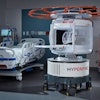A breast MRI computer-aided detection (CAD) algorithm developed at the University of Chicago in Illinois demonstrated good performance in predicting which breast lesions would later metastasize.
Breast MRI CAD is already used to examine dynamic contrast-enhanced (DCE) MRI scans to help breast imagers differentiate benign from malignant tissue. University of Chicago researchers wanted to go one step further and determine whether their internally developed CAD algorithm could predict which malignant lesions would spread and which ones would remain localized.
"Our study has shown that our CAD system can be extended to characterize metastatic malignant lesions and nonmetastatic malignant lesions using a combination of kinetic and morphological features," said Neha Bhooshan, lead author of a study that was presented at the 2008 RSNA meeting in Chicago.
Previous studies have found that computerized kinetic analysis of DCE-MRI can help differentiate between malignant and benign lesions, Bhooshan said. In general, malignant lesions have a rapid uptake and washout, while benign lesions have a slow, persistent uptake.
"Computerized analysis of morphological features can aid in this characterization," she said. "For example, benign lesions tend to have smooth or lobulated margins, whereas spiculated and irregular margins are indicators of malignancy."
The University of Chicago has developed breast MRI CAD software that includes analysis of both morphological and kinetic features. The software has demonstrated good performance in previous research, achieving an area under the curve (AUC) value of 0.85 in a dataset of 181 lesions, she said.
In this study, the researchers sought to assess the performance of computer-extracted morphological and kinetic features in DCE-MRI in determining the prognosis of breast carcinoma, specifically the metastatic nature of the lesion. For the purposes of the study, biopsy of the axillary lymph nodes was used as the ground truth, serving as the surrogate marker for prognosis, Bhooshan said.
The researchers examined 256 biopsy-proven cases, including 56 intraductal carcinoma (IDC) lesions with positive lymph nodes, 67 IDC lesions with negative lymph nodes, and 133 benign lesions with no cysts. The breast MR images were obtained with a T1-weighted spoiled gradient-echo (SPGR) sequence using Gd-DTPA contrast on a 1.5-tesla MRI scanner from GE Healthcare (Chalfont St. Giles, U.K.).
The CAD software automatically segments each lesion, extracting a characteristic kinetic curve for the most enhancing voxels using a fuzzy c-means clustering technique. Textual, morphological, kinetic, and variance-kinetic features are extracted.
For feature selection, the algorithm utilizes stepwise linear discriminant analysis (LDA). The selected features are then merged using a Bayesian neural network in round-robin fashion, and the researchers evaluated the algorithm's classification performance using receiver operator characteristics (ROC) analysis.
Benign lesions tended to have a lower enhancement at the first postcontrast view, as well as a higher curve-shape index, Bhooshan said. Lesions with negative lymph nodes also tended to have lower enhancement at the first postcontrast view.
"As expected, malignant lesions tended to peak at the first and second postcontrast, while benign lesions tended to peak at the fifth or final postcontrast," she said.
Looking at morphological features, benign lesions tended to have lower variance and lower correlation values than the malignant lesions, she said. IDC lesions with negative lymph nodes also tended to have lower correlation values compared to the positive lesions.
The software achieved an AUC value of 0.85 for distinguishing between IDC lesions with positive lymph nodes and IDC lesions with negative lymph nodes. A value of 0.86 was found for distinguishing between IDC lesions with positive lymph nodes and benign lesions, she said.
An AUC value of 0.83 was obtained for distinguishing between IDC lesions with negative lymph nodes and benign lesions, and distinguishing between malignant and benign lesions produced a value of 0.84.
"We believe that further understanding of the characteristic properties of metastatic lesions versus nonmetastatic lesions may influence the treatment and monitoring of breast cancer," she said.
By Erik L. Ridley
AuntMinnie.com staff writer
February 6, 2009
Related Reading
CAD can boost double-reading detection rate, January 22, 2009
Interactive use of mammo CAD may improve mass detection, December 22, 2008
Breast MRI pinpoints residual disease after chemotherapy, December 19, 2008
New mammo CAD approach lowers false positives, December 2, 2008
Breast MRI CAD doesn't improve accuracy due to poor DCIS detection, February 18, 2008
Copyright © 2009 AuntMinnie.com




.fFmgij6Hin.png?auto=compress%2Cformat&fit=crop&h=100&q=70&w=100)




.fFmgij6Hin.png?auto=compress%2Cformat&fit=crop&h=167&q=70&w=250)











